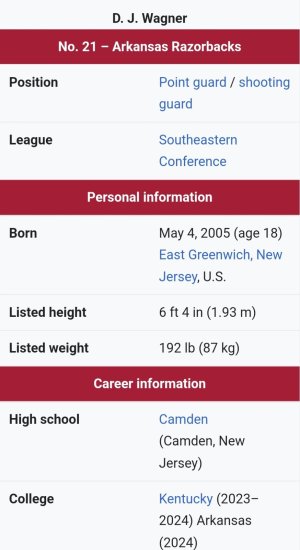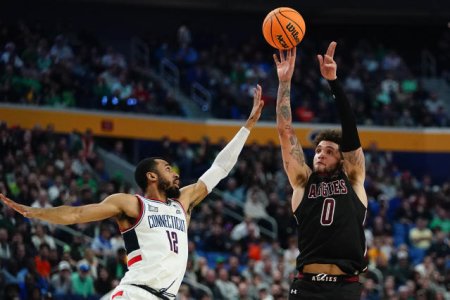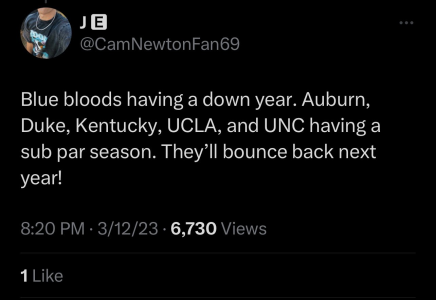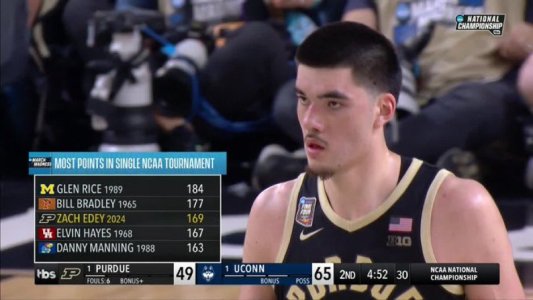February 26, 2009
[font=times new roman, times, serif]More Bracket Building[/font]
Identifying Overachievers
by Pete Tiernan
| Printer-
friendly |  |
|
| |
Believe it or not, most bracket pools are won by someone who gets between 48 and 54 correct picks out of the 63 tourney games. This works out to a 76 to 85 percent accuracy rate. If that seems lower than you expected, remember that inaccurate picks in early rounds reduce the number of later-round games in which you even have a chance to be right. So three out of four ain't too bad.
If 48 out of 63 is the benchmark of winning bracket performance, what constitutes average tourney prediction success? When you consider that even the most clueless bracketeer could adopt a strategy of advancing the higher seed in all matchups, then that should stand as the baseline for tourney prognostication. In this case, every top seed would reach the Final Four. To determine winners in the semis and finals, it would be reasonable to advance the team with the higher victory margin, since PASE stats show that this is the best tourney performance indicator.
I went back over the last 24 tourneys of the 64-team era and figured out how well the "higher seed/bigger margin" strategy would do. Here's the year-by-year breakdown:
The numbers show that you should be able to predict 41 out of the 63 tourney games correctly without even thinking about it. In fact, the baseline bracket picking strategy would have correctly identified seven of the 24 champions in the modern tourney era, including Kansas last year, Florida in 2007 and North Carolina in 2005. Heck, if you had used the higher seed/bigger margin strategy in 2008, you would've correctly pegged the Final Four, called both the finalists and picked the winner.
Of course, this kind of late-round accuracy is an anomaly. Before last year, all four top seeds had never reached the Final Four. Let's face it: picking your bracket solely by seeding isn't exactly a winning strategy. Using this approach would likely put you in contention in just three of the 24 years: 2007 (49 correct answers), 1993 (48 correct answers) and last year (47 correct answers).
Seeding is the single best determinant of a team's tourney fate. It doesn't take a bracket scientist to figure out that the four highest seeds have accounted for 84 of the 96 Final Four teams and won 22 of 24 tourneys in the 64-team era. The real question is: which factors beyond seeding help improve your ability to predict tourney outcomes above the baseline accuracy of 65 percent?
That's where the attribute PASE, or "performance against seed expectations," analysis comes in. By quantifying whether teams possessing a variety of key attributes exceeded or fell short of the win totals that their seeding warranted, we can improve our chances of separating successful high-seeded teams from early flame-outs. We can also identify the low-seeded darkhorses that could deal the upset blows.
This year, we'll examine how 25 attributes rank in their propensity to signal overachievement. Then we'll break our analysis into seed groupings, looking at favorites (one, two and three seeds), contenders (four, five and six seeds), toss-ups (seven through 10 seeds), and longshots (11, 12 and 13). If you want to conduct your own analysis of any combination of seeds and factors, you can go to
www.bracketscience.com and use the handy-dandy Bracketmaster on-line tourney research tool.
Ranking the Top 25 Performance Attributes
If you could know only one stat about a team, besides seeding, to predict its tourney fate, there's no question that the stat would be scoring margin. We crunched the numbers on hundreds of different statistical attributes, and scoring margin easily came out on top in terms of performance against seed expectations. Take a look at the numbers:
(For some of the game play statistics, I have just four or five years of data, so I lowered the 100-appearances requirement to 50.)
The 111 teams with a pre-tourney scoring margin above 15 points per game won nearly 48 games more than seed projections. That works out to a weighty +.429 PASE-about half a game per tourney better than expectations. Perhaps even more impressively, 41 of these 111 squads (37 percent) have reached the Final Four and 12 (11 percent) have won the tourney. Both of these percentages are the highest for any single attribute we examined.
That only begins to explain the importance of victory margin in foretelling tourney overachievement. Consider this: of the top eight attributes I studied, four of them related to scoring margin. Teams that beat opponents by more than 14, 13 and 12 points all had impressive PASE values that would have landed them in the chart above. However, I elected not to repeat similar attributes.
The second most powerful indicator of tourney achievement is turnover margin. The 54 teams that forced opponents into more than three turnovers than they commited won 16 games above seed projections for a +.290 PASE. Right behind turnover margin in the list of top PASE attributes is, perhaps not so surprisingly, assist-to-turnover ratio. Teams that dish out more than 1.23 assists for every turnover they commit have a solid PASE of +.282.
The fourth highest overachieving attribute is offensive firepower. The 141 teams that average more than 85 points a game have won 39 games more than their seeding projected. That works out to a +.277 PASE. The only catch here is that, with scoring on decline since 1989, there are fewer and fewer offensive juggernauts. In the last five years, there have been just six squads to average more than 85 points a game, and three of them have been North Carolina (the others are Arizona in 2004 and Washington and Niagara in 2005). These teams have a collective PASE of +.095. Believe it or not, since 2004, high scoring is more a sign of underachievement. The 35 teams averaging more than 80 points a game are actually -.246 PASE underperformers. So be careful about assigning too much value to offensive firepower in your bracket picks.
There are just two other attributes that have posted PASE values above a quarter-of-a-game per tourney overachievement: field goal percentage differential and combined rebound/turnover margin. The 51 teams with a field goal percentage more than seven percent better than opponents have beaten seed expectations by 13 games for a +.266 PASE. Meanwhile, the 59 teams with a combined rebound and turnover margin of more than six have a +.251 PASE. With apologies to tempo-free purists who would argue that I ought to only include offensive rebounding margins, this stat loosely gauges the number of additional scoring opportunities a team gets over its opponents. (I'm still kicking myself for not separating out offensive boards way back in the early 1990s when I was manually collecting all these stats.)
Rounding out the top ten are two measures of rebounding and shooting ability and two attributes pertaining to coaching experience. Teams with a rebounding margin of better than 5.5 are the seventh best overachievers (+.218 PASE), while teams with shooting accuracy above 48 percent are ninth best (+.162 PASE). As for the value of good coaching, teams with coaches who've been to the Elite Eight more than four times post a +.164 PASE and teams with coaches who've been to the dance more than 15 times own a +.159 PASE.
As interesting as it is to see which attributes correlate to overachievement, it's perhaps more surprising to discover which don't. Just look at the bottom of the list. The low performers debunk a few myths about the secrets of tourney success. The factor with the weakest connection to overperformance is conference affiliation-which ranked 26th and thus missed the list all together. Yes, teams from the Big Six do beat seed expectations, but not by much (+.024). Three-point shooting accuracy also doesn't matter that much (+.033 PASE), nor does RPI ranking (+.034 PASE) or a long pre-tourney winning streak (+.036 PASE).
The Top Indicators of Overachievement for Favored Seeds
While it's important to understand the power of attributes as overachievement indicators across all the seeds, it's perhaps more valuable to learn which attributes correlate to overperformance among more targeted seed groupings. The fact is, higher-seeded overachievers share a completely different set of characteristics than lower-seeded overachievers do.
When it comes to the favored seeds-teams seeded one, two or three-the biggest indicator of tourney overachievement is field goal accuracy differential. The 25 teams that shoot more than six percent better than their opponents have won 15 games more than seed projections, for a hefty PASE of +.600. Here's the rest of the top ten attributes for favored seeds:
The second biggest indicator of overachievement among favored seeds is also related to good shooting. Teams with a field goal percentage higher than 47 percent are +.509 PASE overachievers. Just as it's an indicator of overperformance for all seeds, prolific scoring is also a key performance indicator for the top seeds. The paucity of offensive powerhouses aside, favored seeds scoring more than 85 points a game are better than half-a-game-per-tourney overachievers.
That's one of several top performing attributes that favored seeds share with all the seeds put together. However, take a look at the second column above. It shows where the particular attribute ranks among all seeds. You'll find that certain factors that don't matter as much to the general population of tourney teams are important performance indicators to favored seeds. For instance, the fourth-best overachieving attribute among favored seeds is the percentage of three-pointers shot to overall field goals attempted. One through three seeds that depend on threes for more than 34 percent of their field goals attempted are +.467 PASE overperformers.
What's so astounding about the value of heavy three-pointer reliance is that it really doesn't matter how accurate a team is in making threes; they just have to take a lot of them. How crucial is this distinction between quantity and quality when it comes to threes? Just look at the lowest of the 25 overall attributes. While three quantity is the 14th-best overall attribute, three quality is dead last. Weird, huh?
Another attribute that appears on the favored seed list but not the overall list is free-throw shooting. Having a solid free throw shooting percentage (above 70 percent) is the eighth-best indicator of overachievement among favored seeds, but it's just 20th-best among seeds overall. (Last year's Memphis Tigers are a testament to how important good free throw shooting is for high seeds.) Also, getting a solid scoring contribution from the frontcourt matters much more to favored seeds (+.268 PASE for ninth place) than it does to the average tourney team (+.098 for 16th place).
Conversely, many factors that are key indicators of overperformance for the general tourney population aren't that important to favored seeds. Turnover margin and assist-to-turnover ratio, which were the second- and third-highest indicators of overachievement among all tourney teams, didn't even make the top ten for favored seeds. Heck, even scoring margin-as powerful an overachievement indicator as it is overall-is just the fifth-best attribute among one, two and three seeds. That said, a +.381 PASE isn't anything to sneeze at.
The Top Indicators of Overachievement for Contender Seeds
There's a big difference between what makes favored seeds and the next tier of seeds overachieve. The contender seeds-teams seeded four, five and six-share just four attributes with favored seeds in their top ten PASE list of attributes. Take a gander:
Only four of these attributes are also on the top-ten list for favored seeds. Balanced scoring, coaching experience, victory margin and scoring punch are also important indicators of overachievement among contender seeds. Frontcourt scoring and coaching are even more important to four, five and six seeds. Teams getting between just 25 and 40 percent of their points from guards-in other words, frontcourt-dominant squads-are the second best group of overachievers, with a PASE of +.234. They were ninth-best among the favored seeds and 16th-best overall. Teams led by coaches with more than 15 tourney trips are the third-best group among contender seeds, while they were sixth-best among top seeds.
There's no doubt about it: the differences between favored and contender seed overachievers are more dramatic than the similarities. Look at the top of the list. Contender seeds that have won eight or nine of their last ten games overachieved at a rate of about one-fourth of a game per tourney (+.24

. Favored seeds with similar pre-tourney momentum are actually underachievers (-.047).
That's just one of the big differences between contender seeds and their higher-seeded rivals. Overachieving four, five and six seeds also tend to be more tourney-tested (greater than four consecutive bids), stingier defensively, more reliant on starter scoring and-believe it or not-among the better teams in RPI. What doesn't seem to correlate with contender seed overperformance that does among higher seeds is better shooting, better rebounding and better free-throw accuracy.
Oddly enough, some of the attributes that ranked among the best PASE performers overall were actually signs of underachievement for contender seeds. Having an assist-to-turnover ratio above 1.1 ranked dead last among the 25 attributes we ranked, with a -.184 PASE. (We'll learn in a minute just how different this is for lower seeds.) Meanwhile, a strong combined rebound/turnover margin is also a sign of underperformance among contender seeds (-.148 PASE).
The Top Indicators of Overachievement for Toss-Up Seeds
The key performance indicators for toss-up seeds-squads seeded from seven to ten-are markedly different from those of either favored or contender seeds. Here are the top 10 overachievement attributes:
The numbers show that protecting the ball is the most important characteristic of overachieving toss-up seeds. Not only does a strong assist-to-turnover ratio correlate with the best PASE performance (+.217) on this list, but turnover margin also ranks seventh at +.078. Neither of these attributes was on the favored or contender seed top-ten lists.
Two other factors that seem important to overperformance among toss-up seeds also weren't key attributes among the higher seeds: strength of schedule and regular season winning percentage. The 44 toss-up seeds whose strength of schedule ranking was between 20 and 40 (in other words, tough but not brutal) won eight games more than seeding says they should've, for a sturdy PASE of +.190. Meanwhile, toss-up seeds that post strong pre-tourney records (greater than an .840 winning percentage) are +.074 PASE overachievers.
Scoring balance is also a leading indicator of overperformance among toss-up seeds-but not in the same way that it matters for favored and contender seeds. Whereas higher-seeded overachievers rely more on their frontcourt for scoring (just 25 to 40 percent of their points from guards), toss-up overachievers need imbalanced scoring (either less than 25 percent of points from guards or more than 75 percent). Here's my theory on why this is the case: middling seeds need to present their opponents with a mismatch either at the front- or backcourt to spring upsets. After all, overperformance at the seven, eight, nine and 10 seeds is typically achieved by winning one game against a comparably seeded squad. So the teams that can better exploit mismatches would seem to have an advantage. That's my theory and I'm sticking with it.
One last point about toss-up seeds: while you might think that having an experienced coach would be a valuable asset for advancing in these close-seeded matchups, you'd be wrong. Both the coaching attributes (at least 15 tourney bids and more than three Elite Eight runs) were at the very bottom of the 25 attributes we ranked. Teams with coaches notching a high number of bids were -.126 PASE underachievers; teams with coaches making several deep runs were even less impressive with a -.151 PASE.
The Top Indicators of Overachievement for Upset Seeds
What I find most interesting about the characteristics of overachieving upset seeds-teams seeded 11 through 13-is how "pedigree-related" the attributes are than for the higher seeds. Three of the top four PASE attributes relate to non-game-play statistics. Take a look:
The top overachievement indicator for upset seeds is team experience. The 50 schools that were making at least their third straight trip to the dance beat seed win projections by about 12 games, for a PASE of +.235. Conference affiliation is also a key attribute of upset seed surprisers. Teams that came from one of the Big Six conferences overperformed at a third-best +.162 PASE clip. Finally, coaching experience is a significant overachievement factor as well, with squads led by coaches making their fifth, sixth or seventh appearance in the tourney netting a +.153 PASE.
What's also interesting about upset seed overperformers is how little good shooting seems to matter. Yes, outshooting your opponent is a solid sign of overachievement (a ninth-best PASE of +.076). But raw accuracy actually ended up as three of the four lowest attributes of the 25 we evaluated. In fact, having a free throw percentage better than .700 led to -.185 PASE underachievement. Same goes for having three-point shooting accuracy above .360 (-.182 PASE) and overall field goal accuracy better than .450 (-.061). Go figure.
--
Pete Tiernan has been using stats to analyze March Madness for 19 years. His insights into the NCAA basketball tournament can help you build a better bracket. E-mail him here or visit bracketscience.com.






 . Favored seeds with similar pre-tourney momentum are actually underachievers (-.047).
. Favored seeds with similar pre-tourney momentum are actually underachievers (-.047).




















































